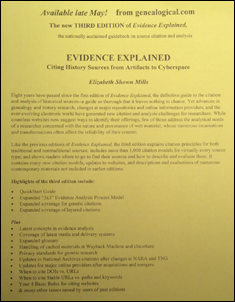Updated edition available late May
One of the key elements of doing genealogy the right way is making sure we cite our sources.
 It’s not just to make sure we can follow the breadcrumbs back to wherever we found a particular piece of information, but rather because it’s really the first step in the analysis of the source we’re using.
It’s not just to make sure we can follow the breadcrumbs back to wherever we found a particular piece of information, but rather because it’s really the first step in the analysis of the source we’re using.
Why do we believe this source? How did the person who created this know? Is this an original record — created at or near the time of the event — or a derivative record that may have been recreated from an original but years later? Is it handwritten or typed? Where was it kept after it was created? Who owns it now?
All of those questions have to be answered before we can craft a citation for this source… and all of them are critical questions for testing the credibility of any bit of information we might find in that source.
So… how do we begin?
By learning the rules of the road… the right way to cite our sources and to analyze the information those sources may offer.
And nobody and nothing sets out the rules of the road better than Elizabeth Shown Mills in her groundbreaking work Evidence Explained.
Which, we learned yesterday here at the 2015 National Genealogical Society Conference in St. Charles, Missouri, has been updated to its third edition — and you can buy it now for release in late May.
The announcement from Genealogical Publishing of Baltimore, Maryland, notes that:
Eight years have passed since the first edition of Evidence Explained, the definitive guide to the citation and analysis of historical sources — a guide so thorough that it leaves nothing to chance. Yet advances in genealogy and history research, changes at major repositories and online information providers, and the ever-evolving electronic world have generated new citation and analysis challenges for researchers. While countless websites now suggest ways to identify their offerings, few of those address the analytical needs of a researcher concerned with the nature and provenance of web material, whose numerous incarnations and transformations often affect the reliability of their content.
Like the previous editions of Evidence Explained, the third edition explains citation principles for both traditional and nontraditional sources; includes more than 1,000 citation models for virtually every source type; and shows readers where to go to find their sources and how to describe and evaluate them. It contains many new citation models, updates to websites, and descriptions and evaluations of numerous contemporary materials not included in earlier editions.
The new edition — 888 pages, indexed, hardcover — adds attention to genetic genealogy sources including a discussion of privacy standards for genetic research, offers the updated and expanded “3×3” Evidence Analysis Process Model, and takes on challenging citation problems like citing online materials we find through the Wayback Machine at Internet Archive and more.
Conference attendees can order the book from the publisher’s booth (under the Genealogical.com banner) in the Exhibit Hall and non-attendees will be able to order directly from the publisher’s website. (The link at the website now shows the second edition as out-of-print, but you can put your name on a “notify me” list here.) Other booksellers, such as Maia’s Books, will also carry it.
The new version is $59.95 plus postage and handling — and conference attendees get a break there: that figure is a whopping one cent.
Evidence Explained 3.
My copy has already been ordered. Is it late May yet?



When I received Mills 2nd edition (only a couple years ago), I sat down and read through it, a few chapters at a time, and realized how little I knew, and how much I had to learn. I’m not ready to pick up the new edition yet, but I have a feeling that the 2nd will work just fine for me for now. Someday, though…
any chance we “live streamers” can get the conference price?
You’d have to pose that question to the folks at Genealogical.com, I’m afraid.
This is great news! I seem to recall that a few years ago, Evidence Explained was offered as a downloadable e-book. Can we look forward to a similar thing at some point for this third edition?
Thanks for passing along the big news. I also am interested in the electronic version of EE3. I looked on the Evidence Explained Bookstore, but didn’t see any reference to the 3rd edition.
Did anyone mention when EE3 would be available electronically?
If it were possible for my current electronic edition of EE2 to be dog eared and worn, it surely would be. I use it all the time.
No schedule was announced for any electronic version.
I love my 1st edition EE, and have been thinking about the 2nd edition. But for me, it’s got to be electronic. 800+ pages is too much to haul around. And it is so much faster to be able to search the book. I understand it will take some time, but please try to arrange this. I’d be happy to pay the same amount, I just want the convenience.
An electronic edition would be a major convenience; we can only hope the publisher moves in that direction soon.
Of course I just bought the 2nd edition!!